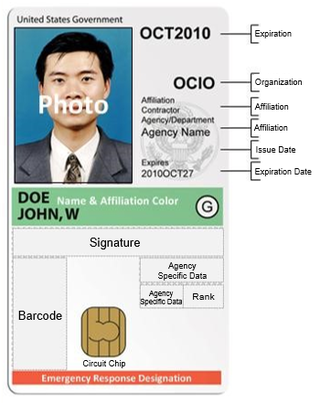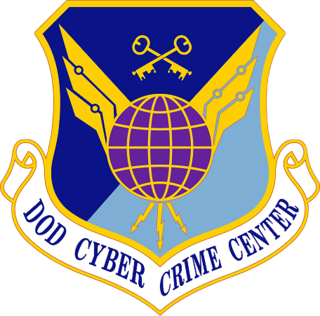Related Research Articles
The U.S. National Security Agency (NSA) used to rank cryptographic products or algorithms by a certification called product types. Product types were defined in the National Information Assurance Glossary which used to define Type 1, 2, 3, and 4 products. The definitions of numeric type products have been removed from the government lexicon and are no longer used in government procurement efforts.
The Federal Information Processing Standard Publication 140-2,, is a U.S. government computer security standard used to approve cryptographic modules. The title is Security Requirements for Cryptographic Modules. Initial publication was on May 25, 2001, and was last updated December 3, 2002.

The Federal Information Security Management Act of 2002 is a United States federal law enacted in 2002 as Title III of the E-Government Act of 2002. The act recognized the importance of information security to the economic and national security interests of the United States. The act requires each federal agency to develop, document, and implement an agency-wide program to provide information security for the information and information systems that support the operations and assets of the agency, including those provided or managed by another agency, contractor, or other source.
The 140 series of Federal Information Processing Standards (FIPS) are U.S. government computer security standards that specify requirements for cryptographic modules.

FIPS 201 is a United States federal government standard that specifies Personal Identity Verification (PIV) requirements for Federal employees and contractors.
Information security standards or cyber security standards are techniques generally outlined in published materials that attempt to protect the cyber environment of a user or organization. This environment includes users themselves, networks, devices, all software, processes, information in storage or transit, applications, services, and systems that can be connected directly or indirectly to networks.
Security controls are safeguards or countermeasures to avoid, detect, counteract, or minimize security risks to physical property, information, computer systems, or other assets. In the field of information security, such controls protect the confidentiality, integrity and availability of information.
Information technology risk, IT risk, IT-related risk, or cyber risk is any risk relating to information technology. While information has long been appreciated as a valuable and important asset, the rise of the knowledge economy and the Digital Revolution has led to organizations becoming increasingly dependent on information, information processing and especially IT. Various events or incidents that compromise IT in some way can therefore cause adverse impacts on the organization's business processes or mission, ranging from inconsequential to catastrophic in scale.

Controlled Unclassified Information (CUI) is a category of unclassified information within the U.S. Federal government. The CUI program was created by President Obama’s Executive Order 13556 to create a streamlined method for information sharing and safeguarding. The Information Security Oversight Office (ISOO) acts as the Executive Agent (EA) of the National Archives and Records Administration (NARA), and is responsible for oversight of the CUI program. The ISOO monitors the implementation of the CUI program by executive branch agencies. CUI will replace agency specific labels such as For Official Use Only (FOUO), Sensitive But Unclassified (SBU), and Law Enforcement Sensitive (LES) on new data and some data with legacy labels will also qualify as Controlled Unclassified Information. Federal contractors who handle CUI will be required to self-assess with the Cybersecurity Maturity Model Certification (CMMC) under the Cyber AB.

The Department of Defense Cyber Crime Center (DC3) is designated as a Federal Cyber Center by National Security Presidential Directive 54/Homeland Security Presidential Directive 23, as a Department of Defense (DoD) Center Of Excellence for Digital and Multimedia (D/MM) forensics by DoD Directive 5505.13E, and serves as the operational focal point for the Defense Industrial Base (DIB) Cybersecurity program. DC3 operates as a Field Operating Agency (FOA) under the Inspector General of the Department of the Air Force.
NIST Special Publication 800-53 is an information security standard that provides a catalog of security and privacy controls for all U.S. federal information systems except those related to national security. It is published by the National Institute of Standards and Technology, which is a non-regulatory agency of the United States Department of Commerce. NIST develops and issues standards, guidelines, and other publications to assist federal agencies in implementing the Federal Information Security Modernization Act of 2014 (FISMA) and to help with managing cost effective programs to protect their information and information systems.
The Federal Information Processing Standard Publication 140-3 is a U.S. government computer security standard used to approve cryptographic modules. The title is Security Requirements for Cryptographic Modules. Initial publication was on March 22, 2019 and it supersedes FIPS 140-2.
Managed Trusted Internet Protocol Service (MTIPS) was developed by the US General Services Administration (GSA) to allow US Federal agencies to physically and logically connect to the public Internet and other external connections in compliance with the Office of Management and Budget's (OMB) Trusted Internet Connection (TIC) Initiative.

The National Institute for Standards and Technology's (NIST) Risk Management Framework (RMF) is a United States federal government guideline, standard and process for risk management to help secure information systems developed by National Institute of Standards and Technology. The Risk Management Framework (RMF), illustrated in the diagram to the right, provides a disciplined and structured process that integrates information security, privacy and risk management activities into the system development life cycle.
Control system security, or industrial control system (ICS) cybersecurity, is the prevention of interference with the proper operation of industrial automation and control systems. These control systems manage essential services including electricity, petroleum production, water, transportation, manufacturing, and communications. They rely on computers, networks, operating systems, applications, and programmable controllers, each of which could contain security vulnerabilities. The 2010 discovery of the Stuxnet worm demonstrated the vulnerability of these systems to cyber incidents. The United States and other governments have passed cyber-security regulations requiring enhanced protection for control systems operating critical infrastructure.
IEC 62443 is an international series of standards that address cybersecurity for operational technology in automation and control systems. The standard is divided into different sections and describes both technical and process-related aspects of automation and control systems cybersecurity.
The Open Trusted Technology Provider Standard (O-TTPS) is a standard of The Open Group that has also been approved for publication as an Information Technology standard by the International Organization of Standardization and the International Electrotechnical Commission through ISO/IEC JTC 1 and is now also known as ISO/IEC 20243:2015. The standard consists of a set of guidelines, requirements, and recommendations that align with best practices for global supply chain security and the integrity of commercial off-the-shelf (COTS) information and communication technology (ICT) products. It is currently in version 1.1. A Chinese translation has also been published.

The External Dependencies Management Assessment is a voluntary, in-person, facilitated assessment created by the United States Department of Homeland Security. The EDM Assessment is intended for the owners and operators of critical infrastructure organizations in the United States. It measures and reports on the ability of the subject organization to manage external dependencies as they relate to the supply and operation of information and communications technology (ICT). This area of risk management is also sometimes called Third Party Risk Management or Supply Chain Risk Management.
NIST Cybersecurity Framework (CSF) is a set of guidelines for mitigating organizational cybersecurity risks, published by the US National Institute of Standards and Technology (NIST) based on existing standards, guidelines, and practices. The framework "provides a high level taxonomy of cybersecurity outcomes and a methodology to assess and manage those outcomes", in addition to guidance on the protection of privacy and civil liberties in a cybersecurity context. It has been translated to many languages, and is used by several governments and a wide range of businesses and organizations.
The Center for Internet Security (CIS) is a US 501(c)(3) nonprofit organization, formed in October 2000. Its mission statement professes that the function of CIS is to " help people, businesses, and governments protect themselves against pervasive cyber threats."
References
- ↑ "Cybersecurity Maturity Model Certification (CMMC) Model Overview. Accessed 2022-04-01" (PDF).
- ↑ "Cybersecurity Maturity Model Certification (CMMC) Model Overview. Accessed 2022-04-01" (PDF).
- ↑ "Chief Information Officer Department of Defense. Accessed 2023-04-17".
- ↑ "Stockholm International Peace Research Institute. "Trends in World Military Expenditure, 2019", pp. 2–3. Accessed Dec. 7, 2020" (PDF).
- ↑ "Strategic Direction for Cybersecurity Maturity Model Certification (CMMC) Program". U.S. Department of Defense. Retrieved December 27, 2022.
- ↑ Ross, Ron; Pillitteri, Victoria; Dempsey, Kelley; Riddle, Mark; Guissanie, Gary (January 28, 2021). "Protecting Controlled Unclassified Information in Nonfederal Systems and Organizations".
{{cite journal}}: Cite journal requires|journal=(help) - 1 2 "Cybersecurity Maturity Model Certification (CMMC)".
- ↑ "Cybersecurity Maturity Model Certification (CMMC) Model Overview. Accessed 2022-04-01" (PDF).
- ↑ "FBI Strategy Addresses Evolving Cyber Threat – Federal Bureau of Investigation". Federal Bureau of Investigation. September 16, 2020. Retrieved January 8, 2021.
- ↑ "Defense Federal Acquisition Regulation Supplement: Assessing Contractor Implementation of Cybersecurity Requirements (DFARS Case 2019-D041)". Federal Register. September 29, 2020. Retrieved January 9, 2021.
- ↑ "Update on the CMMC Timeline". CyberDI. January 5, 2021. Retrieved January 9, 2021.
- ↑ Serbu, Jared (December 15, 2020). "Pentagon reveals first contracts to serve as pathfinders for CMMC". Federal News Network. Retrieved January 8, 2021.
- ↑ Boyd, Aaron (January 4, 2021). "GSA Releases Draft of New Government IT Services Contract Polaris". Nextgov.com. Retrieved January 8, 2021.
- ↑ "OUSD". November 4, 2021. Archived from the original on November 4, 2021.
- ↑ "The Cyber AB Forms Cybersecurity Assessor and Instructor Certification Organization". GovCon Wire. September 29, 2022. Retrieved February 21, 2023.
- ↑ "The Cybersecurity Assessor and Instructor Certification Organization Launches Certified CMMC Professional Exam". www.businesswire.com. October 25, 2022. Retrieved February 21, 2023.
- ↑ "Redspin Becomes the First C3PAO to Perform a Successful JSVAP Assessment". www.businesswire.com. January 5, 2023. Retrieved April 17, 2023.
- ↑ Cybersecurity Maturity Model Certification (CMMC) Program, 88 F.R. 89058 (proposed December 26, 2023) (to be codified at 32 C.F.R. § 170). https://www.federalregister.gov/documents/2023/12/26/2023-27280/cybersecurity-maturity-model-certification-cmmc-program
- ↑ "Tech companies tell DoD its new cyber standards are missing the mark". Federal News Network. March 27, 2020. Retrieved January 9, 2021.
- ↑ "DoD warns vendors about fake third-party CMMC certifiers". Federal News Network. February 24, 2020. Retrieved January 9, 2021.
- ↑ Williams, Lauren C. (September 8, 2020). "CMMC reciprocity guidelines are still a work in progress". FCW. Retrieved January 9, 2021.
- ↑ "Cybersecurity Maturity Model Certification Issues". Fedscoop. July 28, 2020. Archived from the original on July 28, 2020. Retrieved January 9, 2021.
- ↑ "CMMC AB Ousts Chairman Ty Schieber and Mark Berman". Fedscoop. September 16, 2020. Archived from the original on October 1, 2020. Retrieved January 9, 2021.